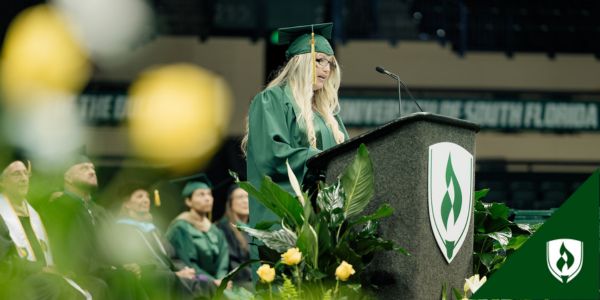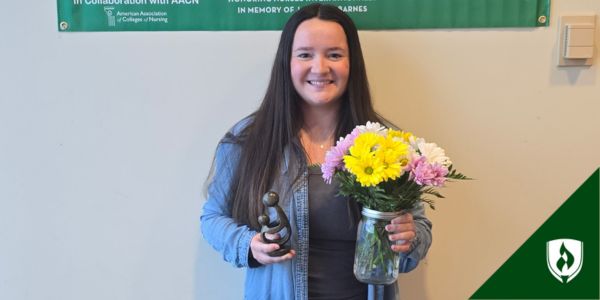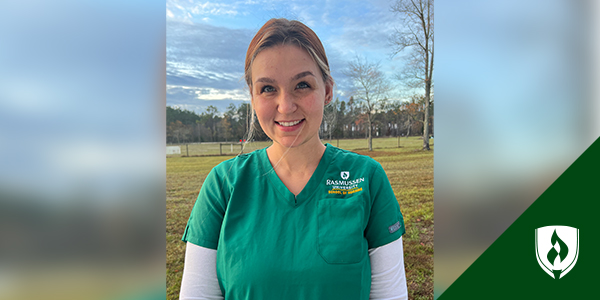Design Student Overcomes Addiction, Becomes Rasmussen University Lead Tutor and Peer Educator of the Year
By Kirsten Slyter on 11/22/2021

Brittany Rawlinson has always been exceptionally good at many things, not just one thing. While her broad range of abilities gave her a lot of options in education and work, it also made it tough to decide on a career path.
Growing up, Rawlinson was a straight-A student—always a grade ahead in science and math. Her mom encouraged her to “do something with her smarts.” She considered herself book-smart, but when she entered her first year of college at a large state university at age 18, she struggled without the kind of structure and support she was used to. “At that kind of university, you’re just a number,” Rawlinson said.
Struggle with Addiction
Rawlinson decided that she couldn’t continue at the state university and, after leaving, she felt lost and quickly began making a series “rash decisions,” as she calls them. After developing a relationship with a member of the United States Marine Corps, Rawlinson became interested in joining the military herself. She needed a job, so she joined the Coast Guard as a cook.
As a part of the military’s medical evaluation, she got her wisdom teeth removed and ended up with dry sockets that led to such a bad infection, she had to go to an emergency department. As a result, she was prescribed 30 doses of oxycodone for just three days.
When another member on the base noticed her taking the medication after a meal, he asked to buy them from her. While she refused to sell them, he taught her how to get high from the medication. Eventually, her drug use escalated to injecting heroin, though she was told it was morphine. When someone noticed her track marks, she was reported to her commander and the entire base was drug tested.
Rawlinson was given a medical work-up and sent to a rehab program, where she even stayed an extra week at her own request. But, within 24 hours of being released, she relapsed, and began dabbling with even harder drugs, like cocaine.
Later, after moving in with her stepmom and dad and turning to alcohol when no drugs were available, she got sober. When her dad, who also battled an alcohol addiction, asked her to attend an Alcoholics Anonymous meeting with him, she felt she couldn’t say no. They got sober together, building an even stronger relationship. Now, she’s been sober 10 years. “Drug addicts are drug addicts because they are self-medicating. I had to figure out what I was trying to heal,” says Rawlinson.
Turning point
Searching for what was next, Rawlinson decided to focus on working and gathered an impressive variety of work experiences. She worked in ophthalmology for 10 years before switching to an office manager position at a chiropractic office when she and her husband moved to Minnesota. “That’s where my interests pivoted and everything changed.”
The chiropractic office was nearly always busy and she handled everything the doctor didn’t do, even short stints of childcare. She would sometimes find herself answering phones with a client’s two-year-old on her hip.
She also created marketing materials for the office. Rawlinson taught herself how to use Adobe® Illustrator® and dusted off some skills from a high school photography class. “That’s where my love for graphic design came into play.” She even painted a ceiling tile for the clients to look at while they got their chiropractic adjustments. Unfortunately, as Rawlinson embraced her passion for design, she ultimately spent so much time working on design projects that she neglected her other responsibilities as office manager and ended up losing that position.
After leaving the chiropractic office, Rawlinson took some time to reflect on her life. She was about to turn 30. “I needed to sit down and figure out what I wanted to do. Not what other people wanted me to do or what other people thought I should do,” she says.
She thought and journaled through questions like “What does an ideal day look like for me?” and “What do I want to do for work almost every day?” Rawlinson knew she wanted to do something with her hands. And she realized how much she loved taking on projects and seeing them through to the end. She could clearly see a design career in her future.
Love for design
Rawlinson had heard about Rasmussen University from the chiropractic doctor she had worked with who had earned an undergraduate degree from the University. Rawlinson had already accumulated 80-some college credits through other online programs. Not only was she already comfortable with online learning, she found that those transfer credits could push her further into the Rasmussen Design program.1
"Growing up, Rawlinson was the kind of the kid who wanted homework on summer break and couldn’t wait to go back to school on Mondays, so Rasmussen’s flexible learning worked well for her. “I really like that Rasmussen is fast-tracked and year-round. I don’t have an entire summer to sit there and twiddle my thumbs".

She loves the continual nature of design, as well. There’s always something to tweak or improve, and something new to learn. “I can get lost in it.” She had never been encouraged to try art or design in school, so she’s been excited to find how much natural ability she has for drawing and designing.
Becoming a peer tutor
In addition to her design classes, Rawlinson has gotten further involved at Rasmussen University through peer tutoring. When she started at Rasmussen, she was working as an ESL teacher online with students in China. However, when the Chinese government started changing their requirements for ESL teachers, she had to look for other work.
Rawlinson kept receiving emails about peer tutoring at Rasmussen University. She figured tutoring college students online couldn’t be all that different from what she had been doing previously, so she applied. Rawlinson got the job and started tutoring for any course she had earned a “B” or higher in—from algebra to sociology to color theory.
Soon Rawlinson was doing much more than only tutoring. She took on the role of lead tutor, as well, which involves meeting with new tutors to provide training and support. She also creates training presentations on topics like time management techniques, dealing with procrastination and tips for staying organized. So far, she’s created and presented five webinars for the University.
As a peer tutor, she’s also learned about the many resources available to Rasmussen University students. “I didn’t know how many resources were available to me until I became a tutor,” she admits. She especially loves recommending Mango Languages to students interested in honing their foreign language skills.
Working as a peer tutor has had a big impact on others—and on herself. “I didn’t know it at the time but getting into tutoring was the catalyst for keeping me in school and motivated,” she says. Through that hard work and motivation, Rawlinson was even named “Peer Educator of the Year” for 2021.
A bright future
Rawlinson is projected to graduate by September 2021 and while she enjoys where she’s at now, it shouldn’t surprise anyone that she has big goals for the future. Rawlinson aims to become a surface pattern designer and design fabric. She’s also passionate about sewing and marrying fashion and function—in high school she was voted “most likely to have their own clothing line.” In the long term, her ideal business would involve creating a sustainable fashion line that focuses on natural materials like wool and linen.
Because of all the hard work she’s done on herself—and the good she does for others—it’s clear that no matter where Rawlinson ends up, she’ll have a positive impact on all those around her.
1Students must complete 33% of their program requirements at Rasmussen University, and no more than 67% may be completed via transfer credits, course waivers, and credit by examination, or other means. Exceptions to this policy are found in the Transfer of Credit Policy in the Course Catalog.
Adobe and Adobe Illustrator are registered trademarks of Adobe Software, Inc.





